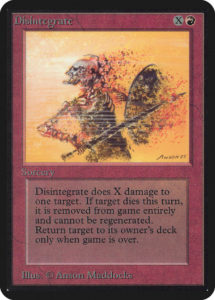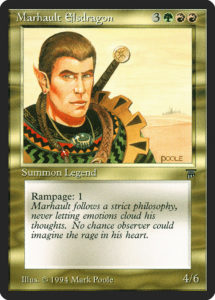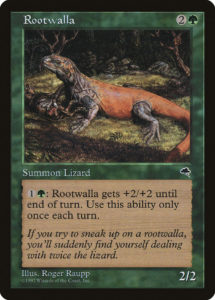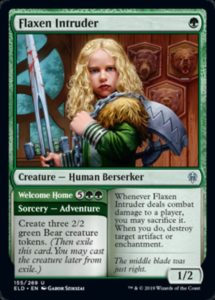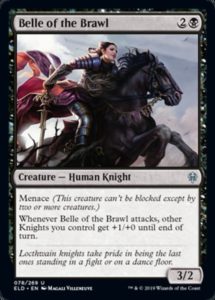Welcome back to the history of how Magic tells its stories! We began our series with traditional narratives. Today, we’ll hit the second of our three types of storytelling: card narratives. (Next week, we’ll hit the final form of storytelling—set narratives.)
Traditional narratives proved difficult for Magic to do because, well, you needed to read a book to get most of the details. It would take a while for Magic to figure out the best way to tell long-form narratives via cards (which we’ll get into next week), however Magic from the beginning was good at telling short stories with individual card designs and via mechanics. So today we’ll go over a whole bunch of Magic’s innovations. Let’s dive in!
In the beginning
There’s a lot of storytelling equity you get from a name, art, and mechanics. Why does Disintegrate exile its target? Why, because it’s burnt to a crisp! If you’ve played D&D or just looked at the art, you understand what moment this card communicates.
Now, this bit of storytelling might not seem like a major innovation, but remember that Magic is twenty-six years old. Back in 1993, Magic was creating the entire collective card game genre, and little stories told players what the game was about and how to imagine it. Cards like Animate Dead, Simulacrum, Stone Giant, and Invisibility all told clean, comprehensible stories in a way that people had never seen in cards without a board.
Now, this era wasn’t full of clear story designs—some were like Island Sanctuary in that they took some thought to parse (I’m guessing you’re on vacation and physically away from your library?). Others either required you to get a reference (Psionic Blast makes sense if you’ve seen psionics in D&D) or don’t make any sense if you take them literally (Black Vise).
This kind of narrative design baked into a card forms the foundation of everything Magic will do going forward. The game develops a whole bunch of tips and tricks for getting more bang for its buck, and these will inevitably lead to Magic finding ways to tell overarching narratives through cards. But this initial innovation—telling a short story via a single card—is the basis for all of Magic’s going forward.
Giving cards some character
Magic took its first forays into resonant design with Arabian Nights and its introduction of singular characters like Aladdin and Sindbad, but Legends made the giant leap forward of having specific, legendary, and Magic-specific characters (oh, and also multicolored cards). For the first time ever, Magic populated its world with specific people, places, and things. Sure, most of this lore was from a D&D campaign nobody knew anything about, but players were now given command of these characters. They could control them on battlefields (well, back when we just called that the far less flavorful “being in play”) and craft their own narratives via play.
Adding some embodiment and legends might also seem like a minor innovation, but consider this: most of the legendary creatures in Legends were awful. Even the Elder Dragon Legends were more cool than good. However, people were excited to play with these cards. Heck, an entire format, Commander, was originally named for these five dragons.
Legends was the first set to give players ownership of not only the cards in their decks, but to provide them with characters they could associate with and imagine being in the fray each game. That’s a lot of opportunity for players to create their own narratives, something that many games and game designers struggle to obtain.
This isn’t even my final form!
Transformation is a common trope in media and one that Magic has communicated in a variety of ways. Sengir Vampire drinks the blood of its prey and grows stronger. Spirit of the Night can be summoned by combining Feral Shadow, Breathstealer, and Urborg Panther. Rootwalla inflates itself while Brushwagg does so to very different effect. Slivers share physiology by proximity. Magic has told the story of a card changing state in a variety of ways.
The first mechanic to play heavily in this space was Threshold. Cards like Krosan Beast demonstrated what would happen if an Otarian squirrel were given a bunch of time to grow (and maybe some of the Mirari‘s power). The problem with Threshold is that the artwork really only communicated half of the change: for example, Mystic Zealot is already flying in its artwork. Sure, his wings are clearly distinct from the rest of his anatomy and you can imagine him without them, but the art is show him post-transformation and not pre-. The mechanic is also used so much that it’s not clear what is happening to cards like Nomad Decoy and Masked Gorgon when they power up.
This issue would be addressed a few years later with Kamigawa’s flip mechanic. Not only did cards like Akki Lavarunner turn into something different, but the cards physically expressed that change via both art and text. This was a major innovation with some flawed execution—Magic cards have to rotate by the game’s rules on tapping, so making cards that are confusing to rotate is a big problem—that would lay the stage for perhaps Magic’s most significant innovation in transformation years later, the Transform mechanic.
Eventide’s Figure of Destiny took a different crack at the question of transformation. It not only produced the first card with four separate states, it’s also the first card to visually communicate three different states (which looks really cool, if a bit hard to parse at that small a size). This innovation made Figure of Destiny one of a small number of cards to have an entire mechanic based upon it. Level Up let you put mana into a creature to turn it into a better creature. This design had the same issue as Threshold—it only visually communicated one of the three stages of transformation, and oftentimes it didn’t show the final and coolest stage of evolution.
Well, all of this came to a head in 2011, with Innistrad’s introduction of double faced cards and the Transform mechanic. Suddenly, Magic cards could visually and textually communicate change in a clear and coherent way. This mechanic has been so effective that we’ve actually seen fewer transformation mechanics and seen sets with as few as one Transform card to tell a story (Nicol Bolas, the Ravager in M19).
Transform is an ideal solution to the question of how to communicate change on a card—a question that Magic has been posing since its beginning and only cracked 17 years later. It’s also a not completely closed issue, since Magic still tells stories of transformation on single-faced cards with Exert, Adapt, and Monstrosity. All of this is to say that it took a long time and a lot of experimentation for Magic to find the best way to tell perhaps the most common type of individual narrative it wants to tell on cards.
Resonant design
Many of Magic’s stories work best when connecting with lore from other forms of media. Unlike traditional narratives, the point isn’t for the player to learn Magic’s story. Instead, Magic gets to use other media to craft cards that might not otherwise make sense. Why does Aladdin steal artifacts? Well, because he’s a thief who does that in 1001 Arabian Nights (or the movie Aladdin, which came out the year before Magic released). Why does Frankenstein’s Monster have such an eclectic mix of counters? Because you’re building him out of corpses.
Magic had many references to D&D, high fantasy, and real world lore in its early days; but we wouldn’t see it commit to an entire top-down set using its own lore until Champions of Kamigawa. That block made the unfortunate but understandable choice of being very true to the source material, which unfortunately meant that Magic’s predominately Western audience had trouble appreciating most of it. Top-down design would not be attempted against until Innistrad let Magic tell its own spin on horror stories as seen in Delver of Secrets, Village Cannibals, Cloistered Youth, and Soul Seizer.
The innovation of Innistrad was the recognition that making recognizable references to another source material was essential, whereas being completely accurate (as Arabian Nights was) or too unfamiliar (as Kamigawa was) made for less compelling Magic sets. This lesson was perhaps best exemplified by Theros’s Shipbreaker Kraken. There are no krakens in Greek mytholgoy—krakens are Scandinavian. However, Clash of the Titans’s arguably most famous line, “Release the kraken!” put Greek krakens into the public consciousness, and so Magic chose to embrace resonance and familiarity over accuracy to the source material. This certainly irked people, but Magic tried to also support them with more obscure designs such as Hundred-Handed One at a higher rarity.
That design innovation—finding resonance with other stories rather than copying them or staying too true to them—has laid the foundation for sets like Amonkhet and Throne of Eldraine. We’re already seeing this on cards like Wicked Wolf (Magic’s twist on the Big Bad Wolf) and Animating Faerie (the faerie who gives Pinocchio life).
We’ve gone over but four of the ways that Magic tells stories via individual cards: simple stories, characters, transformation, and resonance. There are plenty more tools which I encourage you to consider yourself (and would happily go on forever about, but this series needs to end sometime). Next week, we’ll be back with the final innovations that enabled Magic to tell its own long-form narratives via cards.
And, as always, thanks for reading.
—Zachary Barash is a New York City-based game designer and the commissioner of Team Draft League. He designs for Kingdom Death: Monster, has a Game Design MFA from the NYU Game Center, and does freelance game design. When the stars align, he streams Magic (but the stars align way less often than he’d like).
His favorite card of the month is Lava Axe. It’s not a powerful card, but it’s simple and lends itself to powerful moments. There’s something elegant about a card that looks great to an inexperienced player, looks terrible to an intermediate player, and presents an interesting choice to experienced players. Oh, and it lends itself quite well to awesome flavor text.

